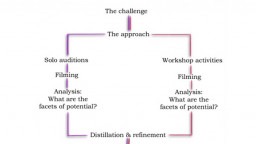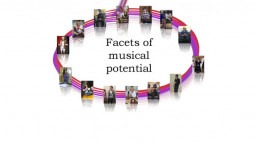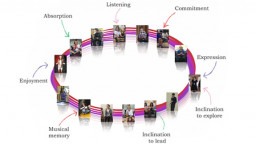1. How can you spot musical potential in a group of young people?
In 2008 Awards for Young Musicians initiated an action research programme to work out how you could spot musical potential in a group of young people. They were interested in how you could identify potential very early on in a child's musical journey before they'd had significant nurturing of their abilities or exposure to music-making activity. They were interested in how you could identify potential, taking into account the breadth of different musical genres, styles and activities without prejudice or favour towards any particular one. And they were interested in how you could identify potential from within a group activity, as so often is what takes place in Primary and Secondary school music-making and in music workshops.


The challenge
Programme summary
Awards for Young Musicians (AYM) instigated this programme in September 2008. AYM aims to tackle some of the major barriers to progression for talented young people from lower income families. One of these barriers is the limited confidence amongst music leaders in how to identify young people’s musical potential and also in how to support and nurture this potential once identified. This is largely because professional development for music leaders, whether they’re working in formal or informal education, tends not to focus on this issue.
As an organisation whose work is specifically focused on supporting young people from lower incomes backgrounds one of AYM’s reasons for initiating this work in the first place was our keen awareness of how limited their musical opportunities can be, even at the earliest stage of involvement in music making. Children from wealthier families will often get the chance to have private instrumental lessons paid for by their parents, whilst those from less well off backgrounds are more likely to have their musical opportunities limited to what their school is able to offer. This makes it even more imperative that, when these opportunities are provided, their teachers have some useful tools to identify their musical potential and help support it.
Core values
This project is about giving the same opportunity and right to every child to show what talent and potential they have. It’s not about identifying a few to the exclusion of others, but about ensuring that those with different kinds of potential are spotted and supported. Obviously it’s part of music leaders’ role and responsibility to ensure their work meets the needs of all young people, including those with exceptional potential.
Clearly there are many young people who have musical potential, but who have never had the chance to have lessons or play an instrument. This Spotlighting project is about demonstrating some useful ways in which music leaders can identify musical potential from within a group of mixed-ability students. There is no ‘one way’ of doing this. We want this project to show some ways in which - through practical music making activities - it is possible to identify facets of musical potential within a group context. We’ll also suggest some ways of supporting that musical potential in the longer term.
Intentions
Definitions
Musical Talent/Musical Potential
The word talent is fraught with difficulties: it’s overused and there is very little consensus on what it means. It’s not our intention to wrestle with the many ways in which the term is interpreted. For the purposes of this project we’d propose the definition of musical talent employed by Awards for Young Musicians, which is this: ‘the need and ability to communicate through music.’
Hugh Nankivell writes: ‘In my experience as a music leader I have rarely found anyone who says that they do not like music. Similarly, I infrequently come across a young person who cannot clap in time or sing in tune. (I do come across those who do not want to clap or sing, especially at secondary school age, but that is different from not being able to). I believe that if they like music, can clap in time and sing in tune (or at relative pitch) then they have musical potential and they fulfil at least the first two of the facets we’re demonstrating within this work. If we agree, this means that all young people have some musical potential. It is therefore really important to be able to identify what musical potential they have and to be able, therefore, to plan (as a music leader) how to develop this potential.’
It might be that those who provide evidence of musical potential on all or most of the facets we’re exploring could be described as being musically talented, and certainly in our research the young people who offer most examples are the ones we have concentrated on, but we also use examples of those who show evidence for one or two facets only.
For these reasons, both within our developing programme and in this Spotlighting project in particular we use the phrase ‘musical talent and potential’
The approach
To begin tackling this Awards for Young Musicians brought together partners Music Leader South West, Exeter and Bristol Universities and South West Music School, alongside Hugh Nankivell as lead facilitating musician and film maker Bob Lockwood.
The programme has so developed in two major strands: an in person training model and the development of a series of film resources. The approach centred around asking music leaders, and others working in music education, to analyse film footage of young people's musical activities for the observable facets of musical potential and ability. Then these facets were distilled and means of supporting that potential and ability were identified.
Solo auditions
The first phase used film footage of South West Music School's entrance auditions. Some auditions were successful, some not. SWMS takes a holistic approach to selecting young people: a solo audition is never used on its own to assess a young person’s musical potential. SWMS therefore combines solo auditions with group activities and an interview. You can find out more about their process on the Facets of Musical Potential visualisation.
Workshop activities
Hugh Nankivell, facilitating musician for this project writes...
"For this research I prepared some material and starting points that could be successfully used with different groups ranging in age from age 8 to 20. This material included musical games, rhythmic exercises (for body percussion and instruments) and songs.
"The reasons for choosing, and designing, this particular material is that it can clearly show individuals within the group playing differently from others and expressing solo ideas and opinions. In this way personal contributions and thereby facets of musical potential can be clearly observed.
"I prepared for each session with a list of games and exercises in a particular order and would generally keep approximately to that list. However, I was also flexible and understood that if a certain game/exercise was proving particularly interesting I could take it a bit further and develop it with the group. Similarly, if a game/exercise was not working particularly well, then I would not pursue it, but move on. I was also aware of the use of technical language when working with the different groups (in terms of age and experience). For instance the word ‘ostinato’ can also be expressed as ‘repeated pattern’ ‘loop’ or ‘riff’ (and more) and it’s useful to know these alternatives and when to use them.
"The different sessions I led ranged from 35 to 90 minutes in length and so I needed to be mindful to achieve all I needed to in the shorter sessions, whilst also having a selection of alternative material handy for the longer sessions.
"As a music leader I need to be comfortable with the material I am using. I use my voice regularly (I write songs) and I believe that singing can be used with most music groups. I am also rhythmically strong and experienced at playing one part while listening to another. These two skills are part of what make up my musical leadership and I use them in many sessions I run. I am aware that other music leaders have different strengths and I strongly believe that each individual should make and design his/her own working method.
"For the sessions I had a list of the material I would use and I’d rehearsed the songs I would sing. I also took along a selection of mixed hand percussion - at least enough for one instrument per person".
We've put together instructions for each group exercise used in this study so that you can use them in your own work.
Analysis: What are the facets of potential?
In the first phase of the programme, in 2009, around 30 classroom teachers, community musicians, and PGCE music students watched the audition footage as part of their training session – they then analysed the performances for the key observable facets of musical potential and ability.
In the second phase of the programme, in 2010, a group of around 30 PGCE students watched the audition footage of the workshop activities and the solo auditions as part of their training session – they then analysed the performances for the key observable facets of musical potential.
In 2011 Hugh Nankivell, Bob Lockwood and the other programme partners then developed the list of possible facets of potential as a result of the group activities Hugh led with young people. These were then refined to come up with the eight key facets demonstrated within this resource.

Distillation and refinement
These two processes took place at different times with different people observing different material but the 'observable facets of musical potential' that emerged from both were pretty much the same. We took this distilled set and consulted various senior experienced figures in music education on their opinions as to how accurate and useful these facets were. We also refined the facets through a third and fourth iteration of the same process of asking people to observe film footage.
